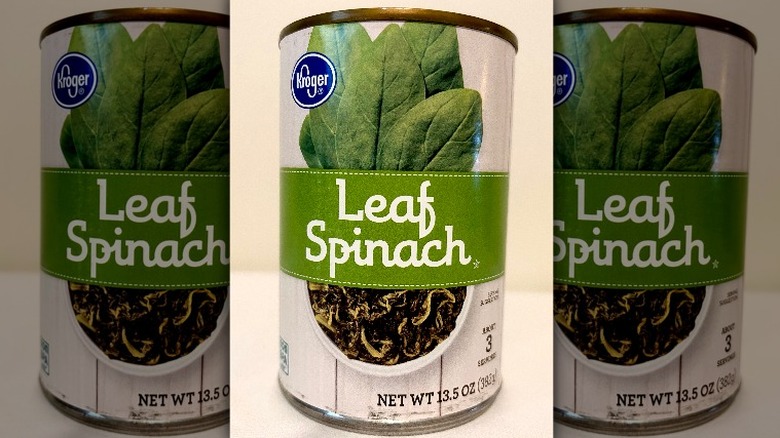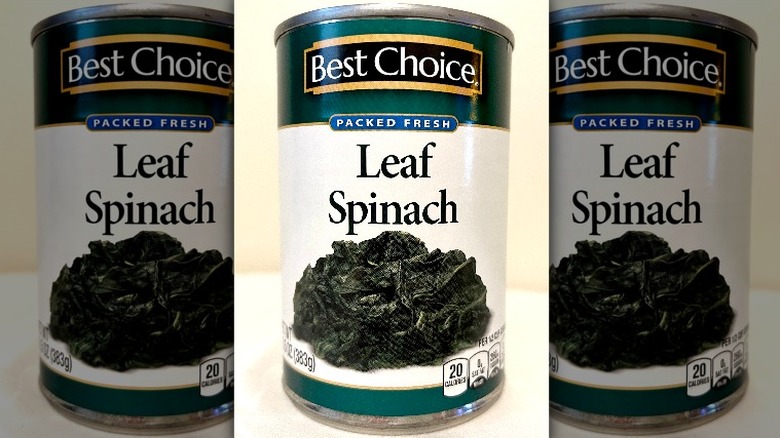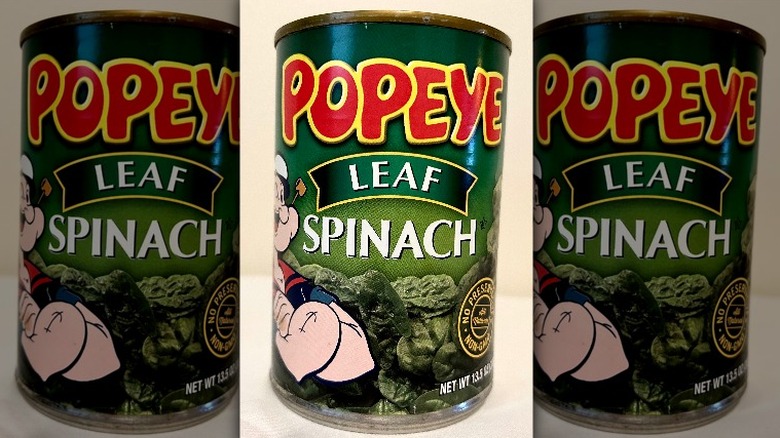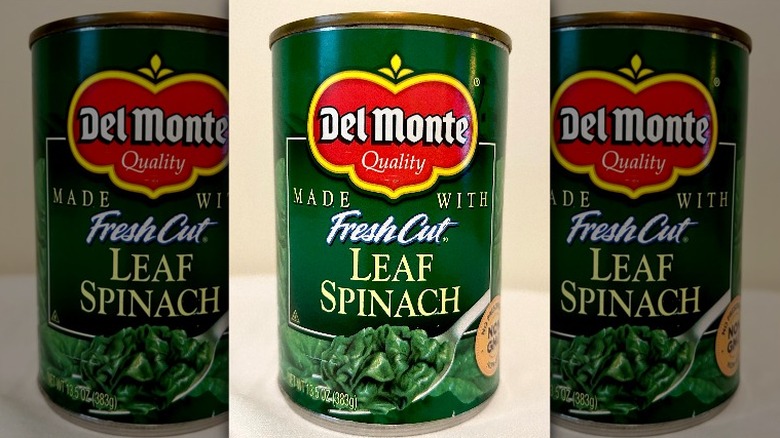7 Canned Spinach Brands, Ranked
When we decided to take on the challenge of ranking canned spinach, we had reservations about the prospect. While we love fresh spinach, we have always been less enthusiastic about the canned iteration. If you have been served spinach straight out of the can and microwaved without anything being done to season it, you might have been left with some not-so-leafy green-related trauma. But be mindful that canned spinach has a place in our world. It is cost-effective, has a long shelf-life, is convenient, highly nutritious, and can help supplement your diet when you cannot obtain fresh spinach.
What we didn't bank on was that finding canned spinach was like searching for a proverbial needle in a haystack. In four days, we went to 11 grocery stores, including numerous well-known grocery chains, and could only find seven brands to review. Once we sat down to begin our evaluations, we factored in the following: smell, color, texture, flavor, aftertaste, residual mouthfeel, the amount of brine in each can, sodium content, and allergen warnings.
In our rankings, we will note particular issues with each brand along with our overall review, ranking them from worst to best. We will also provide some recommendations for making each more palatable or what type of recipe you may consider using them in. Without further ado, here is our list of canned spinach brands ranked.
7. Kroger Leaf Spinach
We admit that we were slightly shocked that the spinach ranking dead last on our list was the Kroger brand. As one of the world's largest retailers, the Kroger brand label has long been known for its quality and consistency, representing about 26% of its total annual sales. Unfortunately, this was not one of its most successfully executed brand-label items. First, it is relatively high in sodium, with 310 milligrams per ½ cup serving. There is also a warning on the label regarding potential cross-contamination with peanuts, which we had not considered checking for when purchasing a can of vegetables.
When you open the can, its aroma is pleasant, smelling faintly like spinach. The moss-colored spinach was soaked in about 1 cup of sour saline brine. What perplexed us was that none of this saltiness made its way to the spinach when we tasted it. In fact, the spinach tasted like absolutely nothing. And its texture was squishy, completely dissolving in our mouths when we tried to chew it.
That said, if you want a neutral flavor, like in a smoothie, you could rinse and strain this spinach well and add it into a breakfast smoothie loaded with fruit, greek yogurt, and honey, providing you with nutrition without much of an aggressive vegetable flavor. As a side dish, however, we'd skip this one.
6. Best Choice Leaf Spinach
We found Best Choice spinach at the Sullivans Foods grocery store. Contrary to its moniker, this brand was not the best choice, but it also was not the worst choice. With 220 milligrams of sodium per ½ cup serving, this was one of the lower sodium brands, which is a win. What is a loss is the allergen warnings on this brand for soy and peanuts, which we found surprising and dismaying. Upon opening the can, this brand did have a pleasant spinach smell. It also had a slightly darker green hue than some other brands, which seemed promising.
The spinach was soaking in approximately ¾ cup of acrid and salty brine. While this spinach at least had a flavor redolent of actual spinach, it also was exceedingly salty. What was more problematic to us was its texture, which was stringy and very gritty. In fact, this grittiness, along with a trace of bitterness, lasted on our teeth for quite a while after swallowing the spinach. It was almost a mineral-like coating on our tongues.
If you properly rinse and strain it, this spinach would be perfectly adequate in a soup, stew, or casserole, like in a lasagna. We recommend chopping it up more before using it to eliminate some of its stringy texture.
5. Great Value Leaf Spinach
Another store brand that landed toward the bottom of our list was the Walmart Great Value brand of spinach. Like most others, this brand contained 310 milligrams of sodium per ½ cup serving. It also had an allergen warning for cross-contamination with peanuts in its processing facility, a trend we did not anticipate. The first thing we noted when opening the can was the sour smell of the spinach, almost like sauerkraut. The spinach had a fern-green hue and floated in approximately ⅔ of a cup of very salty yet bland brine. We mention the amount of brine because it gives you a sense of how much actual spinach is contained in each can, which varies widely from brand to brand.
Our reasoning for placing this brand in the middle of our ranking was that it had a relatively neutral flavor and a soft, but not mushy, texture, which was inoffensive. To sum up our opinion about this spinach in one word, it is — fine. Not bad, not good, just okay. Again, you could easily incorporate this spinach into a soup, stew, or casserole after rinsing and straining it thoroughly without any extra preparation. You might even be able to use it in smoothies since none of the acidity or salinity of the brine seemed to permeate the spinach itself.
4. Glory Foods Seasoned Southern Style Spinach
Glory Foods, located in Effingham, South Carolina, has grown and canned vegetables with a Southern flair since 1838. This was the one brand of spinach we found in every grocery store we visited. The spinach is simmered in onions, garlic, and seasonings before being canned, making it the only flavored spinach we sampled. In addition to these ingredients, this spinach has sugar, soy protein, caramel color, smoke flavor, disodium inosinate, and guanylate. With 680 milligrams of sodium per ½ cup serving, it had the highest sodium content and both soy and peanut allergen warnings.
When you open the can, the aroma of synthetic bacon smacks you. The color of the spinach is an umber hue. While this was a 27-ounce sized can versus a 13.5-ounce can, we noted about 1½ cups of liquid brine in the can, which would be roughly ⅔ cup for an equivalent-sized can to the other brands. Unfortunately, the flavor was so overwhelmingly salty and fake bacon flavored we couldn't taste the spinach. The texture, however, was pleasant and not at all mushy.
We struggled with where to rank this brand because of its distinctive flavor. It almost cannot be compared with the other spinach brands with no added flavors, but since we had to rank it, we put it in the middle. It does have a place in soup or stew recipes with a decidedly Southern flair. You could add it to something like pork and beans or white chicken chili. That said, be very cautious with adding extra salt to your recipe, or the dish will become indelibly saline.
3. Popeye Leaf Spinach
The other spinach brand we found at every store we visited was the Popeye brand, which was not shocking. In fact, what better marketing to get kids to eat their spinach than to tie it together with a cartoon character? That said, we had big expectations for this spinach. While it didn't totally disappoint, it wasn't the best spinach we sampled. Yet again, it contained 310 milligrams of sodium per ½ cup serving and came with a peanut allergy warning. When we popped open the can, we instantly noted that it smelled green, which we can't explain, but you'll know what we mean when you smell it.
This spinach had a high proportion of very acrid brine, ¾ of a cup of it, that was a dirty dishwater color. The spinach itself was brownish in color. What made up for all of this was the flavor, which was surprisingly spinach-like and quite pleasant. Its texture was a bit mushy with a tiny bit of grittiness that lingered in our mouths, but overall, this was a decent spinach. We'd recommend this brand for savory applications rather than as a nutritional supplement for smoothies. It would be a good option for a spinach and artichoke dip but rinse and strain it thoroughly before adding it to your recipe.
2. Del Monte Leaf Spinach
The Del Monte company has been producing and canning high-quality vegetables since 1886, so it isn't surprising that its spinach ended up at the top of our list. Its canned produce is nothing if not consistent. Another spinach with 310 milligrams of sodium per ½ cup serving, this spinach also came with a peanut allergy warning. Its aroma fit under the category of green, though in this case, we'd say it was simply more vegetable-forward than the others. Its color was a darker green than some of the other brands, making us feel like it was canned somewhat fresher than the others.
There was approximately ⅔ cup of yellowish brine with a pleasant vinegar flavor that wasn't overly salty. Its taste was overtly spinachy and lacked the overt salinity that made some other spinach brands less palatable. Its texture was supple without being squishy. We'd call this spinach okay — good even. It would be suitable spinach in any recipe, savory or smoothies, once rinsed and strained. You might even be able to add this spinach to a vegetable fried rice or noodle dish for a bit of extra color and nutritional value without it disintegrating in the pan.
1. Hy-Vee Leaf Spinach
For anyone residing in the midwest of the U.S., Hy-Vee is a recognizable big name in the grocery world. Since 1930, Hy-Vee has been serving up high-quality goods. Its brand-name products are generally consistent and slightly more affordable. We expected this spinach to be good but not to land on top of our list. This spinach stands out from the get-go based on its nutrition label. While it may appear to have more sodium at 340 milligrams, its serving size is ⅔ of a cup. There are also no allergen warnings on this spinach, making it the only one to make that claim. This spinach notes that it is a product of France, which may or may not have skewed our perceptions ever so slightly. And finally, it was the only can with an easy-to-use ring pull pop top opener.
The ultimate decider, however, was the quality of the spinach. Its color was the greenest of all the brands, with a distinctly bright spinach aroma. It also had the least amount of liquid brine in the can, making this a good buy for the money. The brine was vinegary but not unpleasant at all. The texture had the most body, like freshly sautéed spinach, and its flavor was good. We'd use this in any recipe and even consider doctoring it with some garlic, olive oil, and freshly grated nutmeg for a quick side dish. It was by far a superior product compared with all the other brands we sampled.







